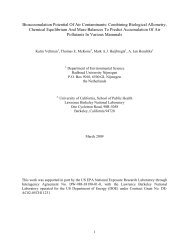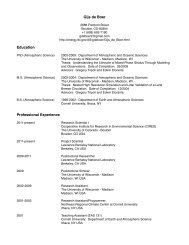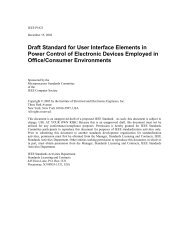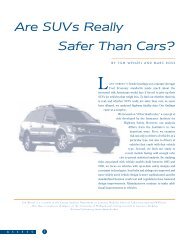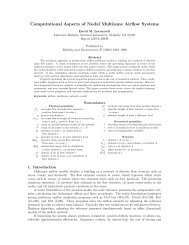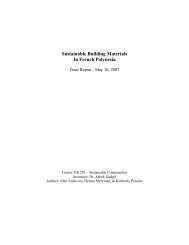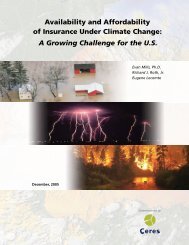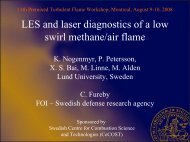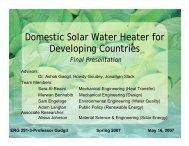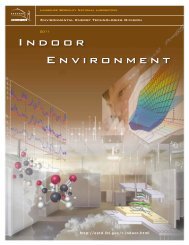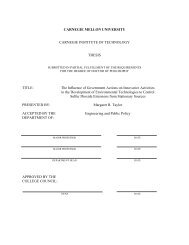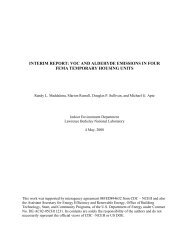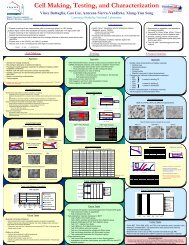indoor-outdoor air leakage of apartments and commercial buildings
indoor-outdoor air leakage of apartments and commercial buildings
indoor-outdoor air leakage of apartments and commercial buildings
Create successful ePaper yourself
Turn your PDF publications into a flip-book with our unique Google optimized e-Paper software.
from outside California. As a result, we can draw no definitive conclusions about the situation<br />
in California. However, the data suggest the following with regard to <strong>commercial</strong> <strong>buildings</strong><br />
overall:<br />
1. Within a given building activity (education, retail, etc.) there appears to be little<br />
systematic variation in leakiness as a function <strong>of</strong> construction type.<br />
2. Within a given construction type (metal-frame, masonry, etc.) there is some evidence<br />
that schools <strong>and</strong> public assembly <strong>buildings</strong> tend to be somewhat tighter than average<br />
<strong>and</strong> that warehouses tend to be leakier than average.<br />
3; BUildings with small "footprints" (i.e. small ro<strong>of</strong> area), under 1000 m 2 , tend to be 25% to<br />
50% leakier, per unit envelope area, than <strong>buildings</strong> with large footprints.<br />
4. Taller <strong>buildings</strong> appear to be slightly tighter than shorter <strong>buildings</strong> (with single'-story<br />
<strong>buildings</strong> being perhaps 10% to 25% leakier than taller <strong>buildings</strong>, per unit envelope<br />
area), but (a) the scarcity <strong>of</strong> tall <strong>buildings</strong> in the database gives us little statistical power<br />
to address this issue, <strong>and</strong> (b) almost all <strong>of</strong> the tall <strong>buildings</strong> are <strong>of</strong>fice <strong>buildings</strong>, so we<br />
cannot distinguish a height effect from an effect <strong>of</strong> building type (item 2).<br />
5. For <strong>buildings</strong> <strong>of</strong> a given construction type <strong>and</strong> activity, footprint size, <strong>and</strong> height,<br />
leakiness per unit envelope area is approximately lognormally distributed, with a<br />
geometric st<strong>and</strong>ard deviation between about 1.7 <strong>and</strong> 2.2.<br />
6. On average, <strong>commercial</strong> <strong>buildings</strong> may be about twice as leaky as single-family houses,<br />
per unit <strong>of</strong> building envelope area.<br />
The deficiencies in the available <strong>commercial</strong> building data could be addressed through<br />
an experimental program to measure <strong>air</strong> exchange rates or <strong>leakage</strong> parameters in a<br />
representative sample <strong>of</strong> bUildings. If such a program is to be undertaken, it should not rely on<br />
the usual past practice <strong>of</strong> using a "convenience sample" <strong>of</strong> <strong>buildings</strong> that happen to be available<br />
to the researchers or in which the building owner or operator is especially motivated to<br />
participate in an experimental program. The use <strong>of</strong> convenience samples has been very<br />
important in the past - indeed, if not for this practice we would have no <strong>commercial</strong> building<br />
measurements at all! However, any future research program needs to be large enough to make<br />
measurements in at least 10 <strong>buildings</strong> in each category on which it focuses, <strong>and</strong> those <strong>buildings</strong><br />
should be selected to be statistically representative <strong>of</strong> their categories. Ideally, a stratified<br />
r<strong>and</strong>om sample <strong>of</strong> the <strong>buildings</strong> in California would be conducted, with stratification used to<br />
ensure that some <strong>buildings</strong> are sampled even for unusual building categories. Such a program<br />
could provide useful, accurate, quantitative data concerning building leakiness. A much less<br />
ambitious program would focus only on specific issues. Rather than simply sampling fewer<br />
<strong>buildings</strong> <strong>of</strong> each type than would be sampled in an ideal program, a less ambitious program<br />
could reduce the scope (in terms <strong>of</strong> the types <strong>of</strong> <strong>buildings</strong> sampled) but still sample at least ten<br />
<strong>of</strong> each type. For instance, an obvious question <strong>of</strong> practical interest is whether <strong>buildings</strong> are<br />
getting tighter (<strong>and</strong> thus, generally, more energy efficient) with age; this could be addressed by<br />
sampling, say, 15 new medium-sized <strong>of</strong>fice <strong>buildings</strong> <strong>and</strong> 15 old medium-sized <strong>of</strong>fice <strong>buildings</strong>,<br />
41



